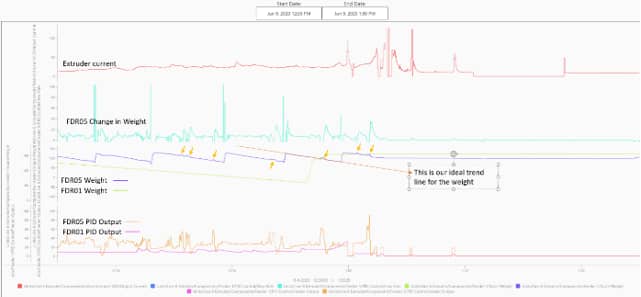CASE STUDY
Ennis-Flint
Continuous Mixing Process - Ignition with Perspective & Edge
The Challenge
Ennis-Flint had developed a new continuous mixing process for a material that had previously been produced in single batch kettle mixers. These mixers will use up to 20 different raw material feeders (vibratory, screw, or volumetric disk feeders) to continuously feed the mixer at the correct ratios determined by the recipe. Due to the nature of a continuous process, fluctuations in feed rates could result in bad product. By trending several tags for each feeder, Ennis-Flint is now able to diagnose and fix such issues as they arise. Ignition is also used to track alarm history and record campaign data at the end of every batch to record raw material consumption.
One of the more difficult aspects of this project involved Ignition development happening in three different cities across the south and southeast, and DSI needed to rapidly re-create and manage environments that allowed developers to work in tandem with each other and in a format that more highly resembled the customer’s environment.
The Actions
A combination of PLC controls and Operator SCADA systems, in conjunction with Ignition, allowed DSI to help develop a much more heavily automated system that allows the customer to automate the flow of recipe information, as well as material consumption, in their ERP. Ignition is architected in a hub and spoke configuration, where the Ignition Edge devices are running locally on OnLogic IGN-600 Edge Onboard devices, which communicate with the central Ignition hub in the cloud over the gateway network. All the data is visualized through Perspective in a mobile-responsive and dynamic application that allows operators and employees to view historical batch information, as well as machine trends.
The tag structures for the project in the PLC were created with Ignition Perspective in mind, and the ability to dynamically look at different facilities and equipment without the need to create duplicate custom screens for each different plant was imperative. Each perspective screen is built in a completely dynamic fashion that is based on the equipment located on each premises and allows the ability to rapidly add new equipment with little to no changes to the Perspective application. This design allows for cost-effective scalability, as well as a cleaner product that feels more consistent for the users.
To solve the issue of rapidly re-creating development environments, DSI employed the use of Ignition through Containerization. Utilizing Docker, we created several Ignition images that allowed us to rapidly deploy and recreate our user’s environment, including their full Ignition Network (all 4 gateways), SQL Servers, DNS, Active Directory, and simulated OPC data. This allowed our developers to spin up an exact copy of the customer’s environment locally and to test changes and fixes more thoroughly before first introducing them to the staging and then production environments on the customer network. With this infrastructure in place, Ennis-Flint can add new mixing systems into the Perspective application in a matter of hours instead of days or weeks.
The Results
The image shows how historical trending was used to trouble shoot motor current issues. Feeder 5 was recording small, momentary increases in weight when the feeder should have been losing weight. As a result, the PID loop controlling the flow out of the feeder would over feed the materials, causing a spike in agitator current and resulting in bad product. These small “bumps” in weight were determined to be the root cause of the motor current faults and bad product. An issue with the shield grounding was discovered, and PLC program modifications were made to make the system less susceptible to bad weight data. With Ignition, they were able to quickly and easily identify the issue and start on a fix to resolve the issue

Winston Salem
Clarksville, TN